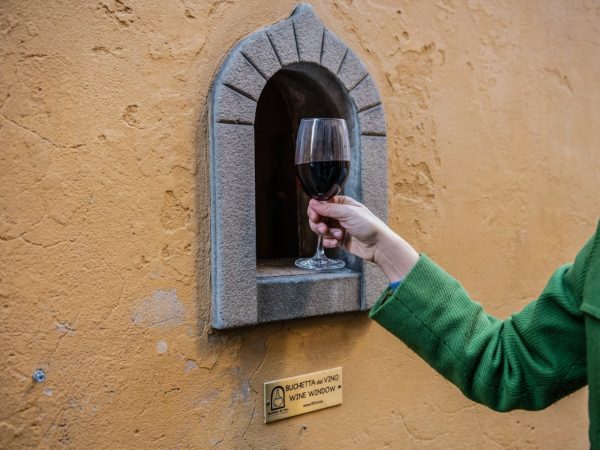When retired Florentine editor Matteo Faglia founded an association in 2015 for the preservation of a small, centuries-old, ubiquitous yet overlooked architectural feature in Florence, little did he fathom that a global pandemic would be a boon to his cause.
Le buchette del vino — wine windows — are foot-high, dome-shaped holes in the thick, stone palazzi of the Renaissance city that six centuries ago were used to sell wine.
Now, with the need for physical distancing — not to mention to add some cheer to Florence’s semi-deserted cobblestoned streets — bars, bistros and even a gelateria are once again pushing open the wooden doors of their buchette and selling everything from glasses of Chianti to ice cream.
“It’s been delightful to see the rediscovery of these very particular Florentine windows, though it’s unfortunate it’s taken a health crisis,” Faglia said. “The fact that we talk about them and understand their historical role can only enrich our experience of the city.”
Buchette began appearing in the 1400s, when Cosimo de Medici, a banker and ruler of Florence, appeased the nobles, whose power he had usurped, by granting them the right to sell the wine they produced in the hillsides surrounding Florence tax-free from their homes.

Windows born of desire to maintain distance
While Florence’s nobility were keen for the profits, Faglia says, they were less thrilled with the idea of welcoming lower social classes and drunken people into their homes, which is likely why the windows were devised. When the bubonic plague struck Florence in 1630, the desire for class distancing morphed into the need for physical distancing.
“Right after the black plague, in 1634, historian Francesco Rondinella wrote a book in which he recounts the wine windows playing an essential function during those years, namely to allow the contactless sale of wine to prevent contagion,” Faglia said.

Almost 200 of the once hundreds of wine windows remain scattered throughout Florence. After their use for selling bottles of wine died out in the 19th century, they were used as spaces to put food or clothing for the poor and, until the 1950s, for the sale of single glasses of wine.
Today, most are found on palaces converted into apartments or publicly owned buildings. Long disused, the dome-shaped holes — just big enough to allow the straw-covered fiasco of wine to be pushed through — have been converted into everything from door bells and mail slots to Christian shrines. Many now have a small sign explaining their history, as a result of the work of the Wine Windows Association.
Above several, such as one on Via delle Belle Donne, or Beautiful Women Street, opening hours are still posted, engraved in a marble plaque: 9 a.m. to 2 p.m. and 5-8 p.m.
WATCH | Italians revive centuries-old pratice during COVID-19 pandemic:

How windows allow Italians to gather for a glass of wine
6 days agoVideo2:12With much of Italy in various stages of lockdown, restaurants in Florence are reopening a centuries-old way of gathering for a glass of wine safely — windows. 2:12
“Only soldiers departing for battle or women who had just given birth had the right to purchase wine after hours,” Faglia said. “It was considered an important source of food. ‘Wine makes blood,’ as they used to say.”
Faglia says the wine windows are utterly unique to Florence and a few surrounding towns, such as nearby Pistoia. There, fellow Wine Windows Association member and tour guide Emiliano Gentili has been documenting them for the past four years.
“We organized a wine window treasure hunt in Pistoia and found nine,” said Gentili, who plans to incorporate the buchette in his historical tours of Florence just as soon as travellers return. “It’s something beyond the usual tourist trap, far from the madding crowd and all that. And of course, when it comes to wine, everybody’s happy.”

Gentili says his favourite is one just steps from Renaissance artist Michelangelo’s house, now a museum.
“I like to imagine that when Michelangelo was a boy, maybe he stopped and had a drink.”
‘These buchette will remain’
While the restrictions due to the pandemic have placed the wine windows in the limelight after centuries of near-obscurity, Gentili isn’t the only one looking at the small windows as an opportunity in post–pandemic Florence.
“I’d like to put on a via delle buchette at night where people can go from buchetta to buchettathroughout Florence tasting different wine,” said Claudio Romanelli, co-owner of Babae bistro in the heart of the city’s historic centre. “Revitalizing something from the past and using it in another way. [Creating] a new attraction.”

Florence is now a yellow zone, where people can eat and drink in and outside restaurants until 6 p.m. When there were more severe restrictions, Romanelli tried enticing customers to get takeout through the buchette but says Italians preferred home delivery.
Today, it’s wine drinkers that congregate around his buchetta — university students and workers in their 30s and 40s sipping a glass of Chianti before closing time, a vestige of the crowds that used to swell outside for the nightly aperitivo.
“I think the COVID is going to disappear very soon,” said one Florentine businessman, sharing a glass of wine with friends, “and these buchette will remain.”



